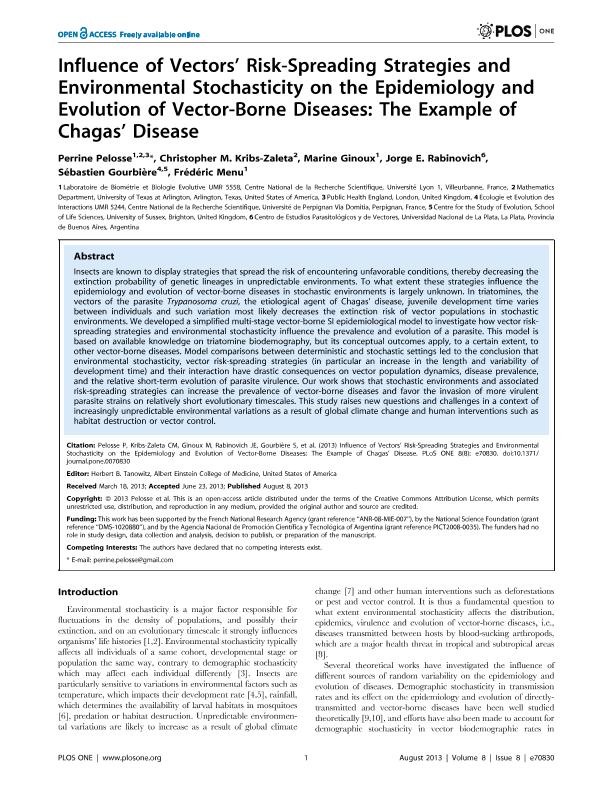Artículo
Influence of Vectors' Risk-Spreading Strategies and Environmental Stochasticity on the Epidemiology and Evolution of Vector-Borne Diseases: The Example of Chagas' Disease
Pelosse, Perrine; Kribs Zaleta, Cristhoper Mitchell; Giniux, Marine; Rabinovich, Jorge Eduardo ; Gourbière, Sébastien; Menu, Frédéric
; Gourbière, Sébastien; Menu, Frédéric
 ; Gourbière, Sébastien; Menu, Frédéric
; Gourbière, Sébastien; Menu, Frédéric
Fecha de publicación:
08/2013
Editorial:
Public Library of Science
Revista:
Plos One
ISSN:
1932-6203
Idioma:
Inglés
Tipo de recurso:
Artículo publicado
Clasificación temática:
Resumen
Insects are known to display strategies that spread the risk of encountering unfavorable conditions, thereby decreasing the extinction probability of genetic lineages in unpredictable environments. To what extent these strategies influence the epidemiology and evolution of vector-borne diseases in stochastic environments is largely unknown. In triatomines, the vectors of the parasite Trypanosoma cruzi, the etiological agent of Chagas' disease, juvenile development time varies between individuals and such variation most likely decreases the extinction risk of vector populations in stochastic environments. We developed a simplified multi-stage vector-borne SI epidemiological model to investigate how vector risk-spreading strategies and environmental stochasticity influence the prevalence and evolution of a parasite. This model is based on available knowledge on triatomine biodemography, but its conceptual outcomes apply, to a certain extent, to other vector-borne diseases. Model comparisons between deterministic and stochastic settings led to the conclusion that environmental stochasticity, vector risk-spreading strategies (in particular an increase in the length and variability of development time) and their interaction have drastic consequences on vector population dynamics, disease prevalence, and the relative short-term evolution of parasite virulence. Our work shows that stochastic environments and associated risk-spreading strategies can increase the prevalence of vector-borne diseases and favor the invasion of more virulent parasite strains on relatively short evolutionary timescales. This study raises new questions and challenges in a context of increasingly unpredictable environmental variations as a result of global climate change and human interventions such as habitat destruction or vector control.
Palabras clave:
Evolution
,
Chagas Disease
,
Trypanoisoma Cruzi
,
Mathematical Modeling
Archivos asociados
Licencia
Identificadores
Colecciones
Articulos(CEPAVE)
Articulos de CENTRO DE EST.PARASITOL.Y DE VECTORES (I)
Articulos de CENTRO DE EST.PARASITOL.Y DE VECTORES (I)
Citación
Pelosse, Perrine; Kribs Zaleta, Cristhoper Mitchell; Giniux, Marine; Rabinovich, Jorge Eduardo; Gourbière, Sébastien; et al.; Influence of Vectors' Risk-Spreading Strategies and Environmental Stochasticity on the Epidemiology and Evolution of Vector-Borne Diseases: The Example of Chagas' Disease; Public Library of Science; Plos One; 8; 8-2013; 70830-70830
Compartir
Altmétricas



